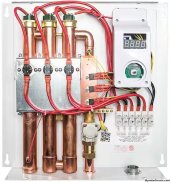Good to hear. I'm debating just buying a heating element for $13, applying random dc voltage, and seeing what happens. I've played with this stuff all my life, but never tried to use it for anything other than it's intended use. In my mind, a heating element is just a wire with resistance that heats up when amps are applied because current is resisted.
Do some math and design it before you buy it or try it.
Resistive heating elements work the same at 240VDC as at 240Vrms AC.
Thermostats and over-temperature safety switches do not; they will fail with high voltage DC. They could be used for "pilot duty" at 24VDC to control a relay or SSR rated for the DC voltage. But as long as you have a non-pressurized tank and element remains underwater (automatic fill valve?) no hazards. Use a suitable DC rated switch to shut off.
Look up the specs of the heating element, 120V or 240V. If it is rated 4800W at 240V, that is 4800W/240v = 20A. 240V/20A = 12 ohms.
With that, you can calculate how much current it would draw at Vmp of your PV string, and how many watts it would deliver.
Probably don't configure series string of PV panels such that Vmp exceeds the 240VAC rating of heating element, to avoid damage.
See if you can make an array 240 Vmp able to deliver around the 20A (if using 4800W element).
And at current grid rates, 230kwh is $43. I'm trying to reduce consumption as much as possible, adding a new thing on the grid is going in the wrong direction.
$0.19/kWh.
PV panels can be had for $0.005/kWh amortized over 20 years, give or take. So 6 months payback compared to using electric grid for heating, if mounting hardware and the rest was free and you wanted the heat year round. 1 year if heating 6 months. Depending on how well you scrounge materials, maybe a few years payback



